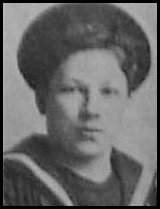Category: Military
Rank: First Class Call Boy J/37894
Regiment or Ship: H.M.S. Queen Mary
Service Number(s): J/37894
Occupation: Schoolboy (1911 Census)
Date of Birth: 14.07.1899
Place of Birth: Hastings, Sussex
Date of Death: 31.05.1916
Place of Death: On board H.M.S. “Queen Mary”, at Battle of Jutland.
Place of Burial / Memorials:
1) Portsmouth Naval Memorial, Hampshire. Panel 14.
2) St. Mary Magdelene’s Church Memorial, Bexhill.
Address: 9, Salisbury Road (1911 Census), Bexhill
Photos and newspaper articles
Family Information
Parents:
Frederick Eldridge, born 1864, in Hastings, Sussex and Florence Violet Couchman, born 1865, in Bethnal Green, London. The marriage took place in the registration district of Battle (possibly Bexhill), in late 1896.
Siblings:
Margaret Eldridge born, 1895 in Mile End, London.
Frederick Eldridge born 1898, in Bexhill, Sussex.
Edith Eldridge, born 1901, in Bexhill, Sussex.
Cicely Dorothy Eldridge born 1903, in Bexhill, Sussex.
Maud Ellen Eldridge born 1905, in Bexhill, Sussex.
Frank Eldridge (probably Richard Frank) born 1907, in Bexhill, Sussex.
Sydney Eldridge (probably Sidney S,) born 1910, in Bexhill, Sussex.
Herbert Eldridge died at the age of 16 and never married.
First World War Experience
A “Call Boy” was a junior rating whose duty it was to carry the boatswain’s pipes, to relay his orders by either shouting or piping messages about the ship so that all the crew were aware of what they were ordered to do, and to take part in the ceremonial piping aboard of visiting dignitaries.
Herbert was only 16 when he signed on for the Royal Navy so his service records would not tell us much but they are available from the National Archives website (see the ‘ADDITIONAL INFORMATION / RESEARCH NOTES’) at a price. From what you are allowed to see, without paying, he had grey eyes, a 32 1/2” chest, and had signed on for twelve years but areas of the records have been hidden.
Herbert had signed on for 12 years but had the misfortune to be on his first sea-going ship, the HMS “Queen Mary”, which was about to take part in the Battle of Jutland in mid-1916. She was hit twice by the German battle cruiser Derfflinger during the early part of the battle and her magazines exploded shortly afterwards, sinking the ship.
The Battle of Jutland was the only time that the British and German fleets of ‘dreadnought’ battleships actually came to blows. It was a confused and bloody action involving 250 ships and around 100,000 men.
The German commander, Admiral Scheer, planned to attack British merchant shipping to Norway, expecting to lure out both Admiral Beatty’s Battle cruiser Force and Admiral Jellicoe’s Grand Fleet, further away at Scapa Flow. Scheer hoped to destroy Beatty before Jellicoe arrived, but the British were warned by their codebreakers and both British forces put to sea early.
On 31st May 1916, Beatty’s battle cruisers, supported by battleships of the 5th Battle Squadron, encountered Admiral Hipper’s German battle cruisers at 2:28pm. The Germans damaged Beatty’s flagship HMS Lion and sank HMS Indefatigable and HMS Queen Mary, both of which blew up when German shells penetrated their ammunition magazines.
This was Herbert Eldridge’s only experience of WW1.
The following is how the local newspaper reported Herbert’s death:-
From the Bexhill Observer, Saturday, 10th June, 1916:-
Bexhill Men in the Great Battle
LOCAL LAD ON THE “QUEEN MARY”
Among those who, it is feared, have sunk on the “Queen Mary” in the recent Naval Battle, is Herbert Eldridge, eldest son of Mr and Mrs F. Eldridge of 2, Salisbury-road, Bexhill.
He was First-class Call Boy on the “Queen Mary”, which was his first seagoing ship and would have been 17 years of age on the 14th of next month. He had only been away from home a year and seven months, and he formerly worked for Mr Lye, of St Leonard’s-road, Bexhill.
Additional Information
Herbert’s Royal Navy Service Records are available, to purchase (at a cost of £3.30, as of February 2015) and download from the “National Archives” website. Search under “Royal Navy Ratings’ Service Records, 1853-1923” and the reference no., for his records, is ADM 188/722/37894). The records may be viewed free, but they been, intentionally, made difficult to read, for obvious reasons.
HMS “Queen Mary” was a Battle Cruiser, weighing 27,250 tons; she was launched in 1912, but was sunk at 16:25 on the 31st May 1916, after receiving direct hits from two Germans ships, Seydlitz and Derfflingerat at the Battle of Jutland. 1,266 men lost their lives.
At some time, Herbert’s Royal Navy Ditty Box, was found but exactly where, when, and how isn’t known. It appeared, as sold, on a website dealing with nautical antiques and aviation collectables, called “Oldnautibits”.
“Ditty Boxes” were lockable pine boxes, issued to sailors, in which they could safely keep their personal possessions, including letters from home. They were all made to a standard design and size.
The photograph shows the brass plate at to the front bearing Herbert’s surname “Eldridge”. The website claims to have researched the origin of the boxes and that they are assured that it is, indeed, Herbert’s. A photograph of the box is shown above.


